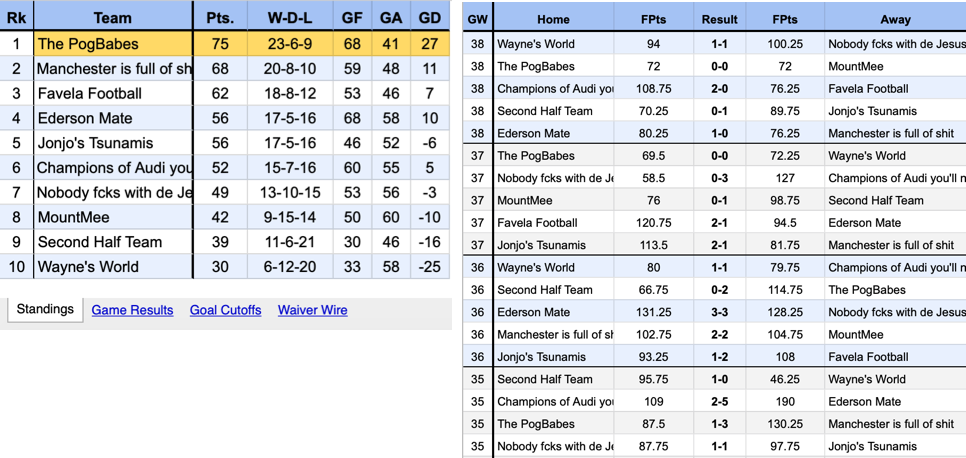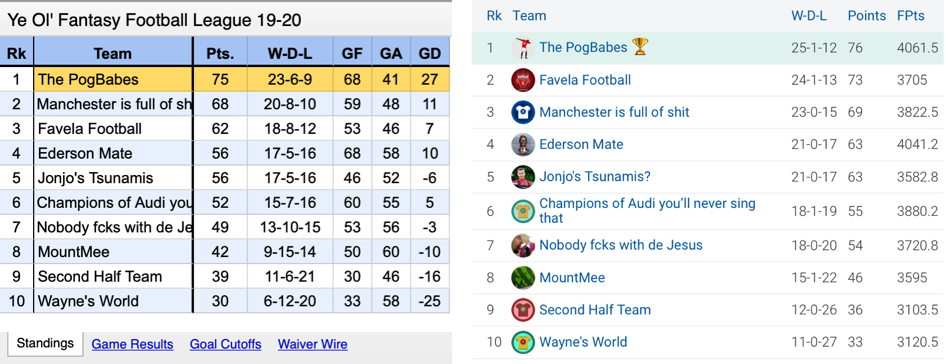Wins, Losses, and DRAWS? Oh my!
On the eve of another EPL season, we wanted to re-up an Overthinking Football classic — our home-baked scoring band system. We use this scoring system in our home league and absolutely love it, and think you might too. If you’re in the mood for something a little different, a little more realistic, and a lot more drama, check out these scoring rules!
When Togga and its new approach to fantasy football scoring arrived on the scene six years ago, the fantasy game took a massive step forward. Not only did Togga introduce the draft, head-to-head format to a wider audience, it emphasized statistical categories that the Official FPL game previously ignored. Rather than depending exclusively on players who could rack up goals, assists, and clean sheets, fantasy managers could now turn to the Kantes of the world – all-around players who piled up peripheral stats, now commonly referred to as “ghost points.” The head-to-head format had its own benefits, allowing fantasy managers to experience the ups and downs of a long season, grinding out three points each game week.
But that’s where one limitation of the Togga (now Fantrax) head-to-head scoring system appears. Outside of the very rare draw, league tables are stuck in three-point increments, as each matchup produces a winner and a loser. Many consider this to be a feature of the system, not a bug, since it promotes high-scoring matchups and gives fantasy managers an opportunity to gloat (or hide) at the end of the weekend. From our perspective, however, the system loses one of the sport’s more interesting elements: the opportunity to pick up points in a down-week, or, if you are unlucky, drop points from a winning position. We set out to tweak the current Fantrax scoring system to better reflect the reality of the Premier League, reintroducing draws in the process.
Before we dive into the details, I want to lay out some our initial goals with this project:
We did not want to rock the boat. Togga’s scoring system (and the slight variation now used as a default in Fantrax leagues) brought so much to the table, and we wanted to work within the confines of these scoring rules. As a result, we opted to add a scoring layer to the back-end of each game week, rather than mess with players’ individual point tallying rules. John Wallin did the hard work – we were just adding our own wrinkle. While the scoring rules in our home league described below have some adjustments to the default scoring (sorry @FantasyGaffer), the system described in this article can be applied to the default scoring rules, or any other rules.
We sought to more fairly distribute points to worthy teams. We were tired of the weeks where two squads put up dismal performances, but one of the teams inevitably walked away with three points. We similarly found it frustrating when two teams performed on a nearly equal level (i.e., 120 pts. to 119 pts.), but only one team got the win. Yes, these close matchups are in some ways what makes head-to-head fantasy great. Our system does not get rid of these nail-biting moments, but instead shifts them towards the “goal” thresholds, leaving managers stressing over whether they can score their next “goal,” while also worrying if their opponent might sneak in a late equalizer to steal a point.
We wanted game week outcomes to be realistic! As mentioned above, one of the driving factors behind our development of this scoring system was to make matchup outcomes and, as a result, the league table, more closely resemble the Premier League itself. We did this in two ways: (1) having individual matchups be determined by “goals” rather than total fantasy points; and (2) calculating our “goal” thresholds in a manner that led to result distributions resembling those found in the Premier League. Whereas 24.21% of matches in the 19/20 Premier League season resulted in draws, 21.58% of our fantasy matchups resulted in split points.
So now down to the secret sauce. Ultimately, we needed a conversion system that resulted in the same number of goals for a given fantasy matchup as you tend to see in a real-life Premier League match. We didn’t want to routinely see 8-5 wins or 6-6 draws, because while goals are fun, this defeats the entire purpose of making the game more realistic. First, we needed to define what a “realistic” outcome is in this context. To accomplish this, we gathered data from every Premier League match from the last two seasons and found the distributions of goals scored in each game (Figure 1A). It turns out that in approximately 30% of matches, Premier League teams individually score 0 goals. Therefore, we also wanted teams in our fantasy league to be awarded 0 goals in approximately 30% of matches as well. To accomplish this, we looked at the distribution of fantasy points scored for matchups in our league from the previous season (Figure 1B), and found the 30th percentile of team fantasy scores. Anything below this margin is considered 0 goals. In our case, this corresponded to around 80 fantasy points. This process was then repeated for all goal outcomes seen in the Premier League. Since in about 33% of games, teams scored a single goal, it follows any fantasy point outcome between the 30th (~80 fpts) and 66th percentile (~100 fpts) should count as a single goal. Rinse, wash, and repeat for all possible goal outcomes and you’ve got yourself some empirically determined cutoffs that directly match the Premier League! The matching of distributions between team fantasy points and premier league goals can be visualized in Figure 1.

In its debut season in our 10-team home league, the scoring system was a huge success. Because we had to convert everything outside of Fantrax’s system, we displayed our league standings and match results on a Google Sheet that we updated after each game week. Luckily, Fantrax’s customizable league home page allowed us to link to the Google Sheet using the Commissioner Messages feature, so our standings and results displayed in a similar manner to the standard layout.

Overall, our league results turned out pretty similar to how they would have with the traditional head-to-head matchup scoring. As you can see below, only one team, Favela Football, swapped positions, moving up from third to second place. The highest total points scoring team still finished in first, despite finishing with five more draws than in the traditional scoring format.

I am sure some of you are reading this thinking that adopting this scoring change is not worth it, considering that it ultimately did not change the overall results too dramatically. I am also sure that some of you are reading asking why we would voluntarily add draws to any sporting event – a fair question! To put it simply, this modified scoring system just made our league more fun. It made it easier for weaker teams to steal some points (sure, your team is good, but can you do it on a cold, rainy night at MountMee?), while also not rewarding those managers who undeservedly got a win with a disastrous performance. It made nearly every game week interesting down to the final match, rather than allowing one Michail Antonio masterclass to guarantee a win. It forced managers to rethink their strategy – would a 7-point Fred performance that bumped you to the next goal threshold be better than throwing in Jack Grealish against Manchester United? And, perhaps most importantly, it fundamentally was the same game that we all love, where you can be one Tarkowski aerial or Adama take-on from victory or defeat.
We know this scoring system will not be for everyone. In fact, we know most of you may not like it. But while we are more than happy to continue playing with our new scoring system on our own, we also wanted to provide the opportunity to similarly adventurous leagues to give it a go. If the above interests you, feel free to reach out and we can work to develop league-specific goal thresholds that will allow you to introduce a new element to your competition. And maybe one day, if the Fantrax EPL gods are kind, we won’t be left calculating game results in a Google Sheet.




